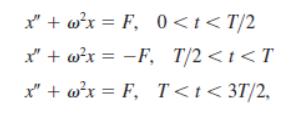In Problem 27 in Chapter 5 in Review we examined a spring/mass system in which a mass
Question:
In Problem 27 in Chapter 5 in Review we examined a spring/mass system in which a mass m slides over a dry horizontal surface whose coefficient of kinetic friction is a constant µ. The constant retarding force fk = µmg of the dry surface that acts opposite to the direction of motion is called Coulomb friction after the French physicist Charles Augustin de Coulomb (1736–1806). You were asked to show that the piecewise-defined differential equation for the displacement x(t) of the mass is given by

(a) Suppose that the mass is released from rest from a point x(0) = x0 and that there are no other external forces. Then the differential equations describing the motion of the mass m are

And so on, where ω2 = k/m, F = fk/m = µg, g = 32, and T = 2π/ω. Show that the times 0, T/2, T, 3T/2, … correspond to x'(t) = 0.
(b) Explain why, in general, the initial displacement must satisfy ω2|x0| > F.
(c) Explain why the interval –F/ω2 ≤ x ≤ F/ω2 is appropriately called the “dead zone” of the system.
(d) Use the Laplace transform and the concept of the meander function to solve for the displacement x(t) for t ≥ 0.
(e) Show that in the case m = 1, k = 1, fk = 1, and x0 = 5.5 that on the interval [0, 2π] your solution agrees with parts (a) and (b) of Problem 28 in Chapter 5 in Review.
(f) Show that each successive oscillation is 2F/ω2 shorter than the preceding one.
(g) Predict the long-term behavior of the system.
Step by Step Answer:

A First Course in Differential Equations with Modeling Applications
ISBN: 978-1111827052
10th edition
Authors: Dennis G. Zill





